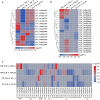Comparative transcriptomic and physiological analyses of weedy rice and cultivated rice to identify vital differentially expressed genes and pathways regulating the ABA response
- PMID: 34145345
- PMCID: PMC8213743
- DOI: 10.1038/s41598-021-92504-5
Comparative transcriptomic and physiological analyses of weedy rice and cultivated rice to identify vital differentially expressed genes and pathways regulating the ABA response
Abstract
Weedy rice is a valuable germplasm resource characterized by its high tolerance to both abiotic and biotic stresses. Abscisic acid (ABA) serves as a regulatory signal in plant cells as part of their adaptive response to stress. However, a global understanding of the response of weedy rice to ABA remains to be elucidated. In the present study, the sensitivity to ABA of weedy rice (WR04-6) was compared with that of temperate japonica Shennong9816 (SN9816) in terms of seed germination and post-germination growth via the application of exogenous ABA and diniconazole, an inhibitor of ABA catabolism. Physiological analysis and a transcriptomic comparison allowed elucidation of the molecular and physiological mechanisms associated with continuous ABA and diniconazole treatment. WR04-6 was found to display higher ABA sensitivity than SN9816, resulting in the rapid promotion of antioxidant enzyme activity. Comparative transcriptomic analyses indicated that the number of differentially expressed genes (DEGs) in WR04-6 seedlings treated with 2 μM ABA or 10 μM diniconazole was greater than that in SN9816 seedlings. Genes involved in stress defense, hormone signal transduction, and glycolytic and citrate cycle pathways were highly expressed in WR04-6 in response to ABA and diniconazole. These findings provide new insight into key processes mediating the ABA response between weedy and cultivated rice.
Conflict of interest statement
The authors declare no competing interests.
Figures








References
-
- Burgos NR, Norman RJ, Gealy DR, Black H. Competitive N uptake between rice and weedy rice. Field Crop Res. 2006;99:96–105. doi: 10.1016/j.fcr.2006.03.009. - DOI
Publication types
MeSH terms
Substances
LinkOut - more resources
Full Text Sources

